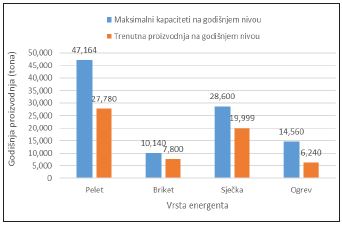Forest wood biomass and wood residues in the function of energy source production in the area of Tuzla canton–potentials and opportunities
DOI:
https://doi.org/10.7251/GSF1929029HKeywords:
briquettes, pellet, Public Forest Company of Tuzla Canton, renewable energy sources, wood biomass, wood chips, wood residuesAbstract
Ascertaining the production capacity of secondary energy sources in the area of Tuzla Canton offers an important stronghold for a more detailed and rational plan for exploiting wood waste from different sources, originating in the above-mentioned area.
For the purpose of this research, the method of analysis and synthesis is used, in addition to the comparative analysis based on the data sources gained from the proprietors of production facilities of secondary energy sources, as well as wood processing enterprises and the enterprises managing the forests in the Tuzla Canton, and in addition to all other relevant documentation from the Tuzla Canton Chamber of Commerce, based on the Business Report and statistical bulletins.
According to the available data received from 21 wood processors in the area of the Tuzla Canton, the annual amount of processed wood (in 2017) is 118 383.00 m3. Based on this data, the estimated amount of wood waste as a result of wood processing is approximately 36 306 m³ per year.
The actual realisation of fuel wood with retail sale in the Šuma TK public company is 96 007 m3. Moreover, from the total large volume of wood cut in forests, one part remains there, unused. On an annual basis, with regard to the Tuzla Canton forests, that is (the difference between gross and net wood volume) around 36 175 m3 of unused wood waste which could be used as energy source.
In the Tuzla Canton, there are wood processors (chopping) who use vertical hydraulic log splitters. The facility capacity for fuel wood in the Tuzla Canton is 14 560 m³ annually, with an actual realisation of 6240 m3 or 43%.
The current capacity for pellet production in the Tuzla Canton is approximately 47 564 tons annually, with an actual realisation of 27 780 tons or 59%.
Regarding the value of briquettes, the facility capacity is 10 140 tons on an annual basis, with the realisation of 7800 tons or 77%.
What has recently become especially evident is woodchips used as an energy source for heating of individual housing units as well as settlements. The annual capacity in the area of the Tuzla Canton is 28 600 tons, while the actual production per year is 20 000 tons (70%). The stated percentages indicate that the capacities have not been fully employed.
The largest number of facilities for the production of pellets and briquettes, and woodchips and fuel wood are located in the area of the municipalities of Kladanj and Gračanica.
In order to ensure a cost effective and sustainable pellet and briquette production, the necessary amount of raw material has to be made available. The total amount of wood waste in the Tuzla Canton is not sufficient for the maximum capacity of installed production facilities of secondary energy sources. In this case, the raw material has to be procured from a larger area in Bosnia and Herzegovina, and wood waste has to be used more efficiently, especially regarding sprout forests. As a raw material basis, there is also the possibility of managing energy plantations with fast-growing species etc.

Downloads
Published
Issue
Section
License
Copyright (c) 2019 Velid Halilović, Jusuf Musić, Dino Hadžidervišagić, Admir Avdagić, Jelena Knežević, Edin Brčaninović

This work is licensed under a Creative Commons Attribution 4.0 International License.

